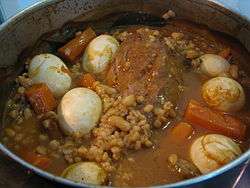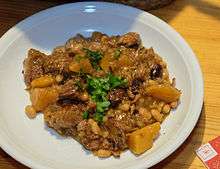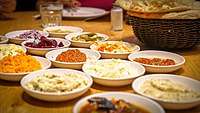Cholent
Cholent (Yiddish: טשאָלנט, romanized: tsholnt or tshoolnt) or hamin (Hebrew: חמין) is a traditional Jewish stew. It is usually simmered overnight for 12 hours or more, and eaten for lunch on Shabbat (the Sabbath). Cholent was developed over the centuries to conform with Jewish laws that prohibit cooking on the Sabbath. The pot is brought to a boil on Friday before the Sabbath begins, and kept on a blech or hotplate, or left in a slow oven or electric slow cooker, until the following day.
 | |
| Type | Stew |
|---|---|
| Main ingredients | Meat, potatoes, beans, barley |
There are many variations of the dish, which is standard in both the Ashkenazi and Sephardi kitchens.[1] The basic ingredients of cholent are meat, potatoes, beans and barley. Sephardi-style hamin often uses rice or wheat kernels and chickpeas instead of beans and barley, and chicken instead of beef. A traditional Sephardi addition is whole eggs in the shell (huevos haminados), which turn brown overnight. Ashkenazi cholent often contains kishke (a sausage casing) or helzel (a chicken neck skin stuffed with a flour-based mixture). Slow overnight cooking allows the flavors of the various ingredients to permeate and produces the characteristic taste of cholent.
Etymology
Max Weinreich traces the etymology of cholent to the Latin present participle calentem (an accusative firm of calēns), meaning "that which is hot" (as in calorie), via Old French chalant (present participle of chalt, from the verb chaloir, "to warm").[2][3]
One widely quoted folk etymology derives the word from French chaud ("hot") and lent ("slow"). Another folk etymology derives cholent (or sholen) from the Hebrew she-lan, which means "that rested [overnight]". This refers to the old-time cooking tradition of Jewish families placing their individual pots of cholent into the town baker's ovens that always stayed hot and slow-cooked the food overnight. Another possible etymology is from Old French chaudes lentes (hot lentils).[4]
Hamin (חמין, pronounced ḥamin), the Sephardi version of cholent popular also in Israel, derives from the Hebrew word חם ('hot'), as it is always served fresh off the stove, oven, or slow cooker. The origin of this name is the Mishnaic phrase tomnin et ha’chamin (Hebrew for "wrap the hot things"),[5] which essentially provides the Rabbinical prescription for keeping food hot for the Sabbath without lighting a fire.[6][7]
The Arabic words used in Morocco are sakhina (سخينة diminutive of "hot") and dafina (دفينة diminutive of "buried").[8]
Traditional Shabbat food

In traditional Jewish families, Ashkenazi, Sephardi, and Mizrahi, cholent or hamin is the hot main course of the midday Shabbat meal served on Saturdays after the morning synagogue services. Secular Jewish families in Israel also serve cholent. The dish is more popular in the winter. Cholent may be served on Shabbat in synagogues at a kiddush celebration after the conclusion of the Shabbat services, at the celebratory reception following an aufruf (when an Ashkenazi Jewish groom is called up to the Torah reading on the Shabbat prior to the wedding) or at bar and bat mitzvah receptions held on Shabbat morning.
Lighting a fire and cooking food are among the activities prohibited on Shabbat by the written Torah. Therefore, cooked Shabbat food, such as cholent or hamin, must be prepared before the onset of the Jewish Shabbat – by some as early as Thursdays and certainly not later than Friday afternoon. The pre-cooked food may then be kept hot for the Shabbat meal by the provision in the Rabbinical oral law, which explains that one may use a fire that was lit before Shabbat to keep warm food that was already cooked before Shabbat.[6][7]
Rabbi Zerachiah ben Isaac Ha-Levi Gerondi (Hebrew: רבינו זרחיה הלוי), the Baal Ha-Maor (author of the book Ha-Maor), went as far as to write that "he who does not eat warm food (on Shabbos) should be checked out to see if he is not a Min (a heretic)".[9] The reasoning behind such austerity is that the Karaites interpreted the Torah verse, "You shall not [burn] (Heb: bi‘er the pi‘el form of ba‘ar) a fire in any of your dwellings on the day of Shabbat" to indicate that fire should not be left burning in a Jewish home on Shabbat, regardless of whether it was lit prior to, or during the Sabbath. In Rabbinic Judaism however, the qal verb form ba‘ar is understood to mean "burn", whereas the pi`el form (present here) is understood to be not intensive as usual but causative. (The rule being that the pi'el of a stative verb will be causative, instead of the usual hif'il.) Hence bi`er means "kindle", which is why Rabbinic Judaism prohibits only starting a fire on Shabbat.
History
Ashkenazi-style cholent was first mentioned in 1180, in the writings of Rabbi Yitzhak of Vienna.[10] In the shtetls of Europe, religious neighborhoods in Jerusalem and other cities in Israel before the advent of electricity and cooking gas, a pot with the assembled but uncooked ingredients was brought to the local baker before sunset on Fridays. The baker would put the pot with the cholent mixture in his oven, which was always kept fired, and families would come by to pick up their cooked cholent on Saturday mornings. The same practice was observed in Morocco, where black pots of s’hina (see Variations below) were placed overnight in bakers’ ovens and then delivered by bakers’ assistants to households on Shabbat morning.[11] The unique cooking requirements of cholent were the inspiration for the invention of the slow cooker.[12][13]
Variations

In Germany, the Netherlands, and European countries the special hot dish for the Shabbat lunch is known as schalet, shalent, or shalet.[11] These western Yiddish words are straight synonyms of the eastern Yiddish cholent.[14]
The Jewish people of Hungary adapted the Hungarian dish sólet to serve the same purpose as cholent. Sólet was likely modified by the Jewish people living in Pannonia when the Magyars arrived.[15]
In Morocco, the hot dish eaten by Jews on the Sabbath is traditionally called s’hina or skhina (Arabic for "the warm dish";[16] Hebrew spelling[17] סכינא). S'hina is made with chickpeas, rice or hulled wheat, potatoes, meat, and whole eggs simmering in the pot.[11]
In Spain and the Maghreb a similar dish is called adafina or dafina, from the Arabic d'fina or t’fina for "buried" (which echoes the Mishnaic phrase "bury the hot food").[16] Adafina was popular in Medieval Judeo-Iberian cuisine, but today it is mainly found as dafina in Jewish communities in North Africa.
The Sephardic Jews of the Old City of Jerusalem used to eat a traditional meal called macaroni hamin that consists of macaroni, chicken and potatoes. It was traditionally flipped upside down when served, just like maqluba.
In Bukharan Jewish cuisine, a hot Shabbat dish with meat, rice, and fruit added for a unique sweet and sour taste is called oshi sabo (or osh savo).[18] The name of the dish in Persian or Bukharian Jewish dialect means "hot food [oshi or osh] for Shabbat [sabo or savo]", reminiscent of both hamin and s'hina.
Among Iraqi Jews, the hot Shabbat meal is called t'bit and it consists of whole chicken skin filled with a mixture of rice, chopped chicken meats, and herbs.[11] The stuffed chicken skin in tebit calls to mind the Ashkenazi helzel, chicken neck skin stuffed with a flour and onion mixture that often replaces (or supplements) the kishke in European cholent recipes.
Ethiopian Jews traditionally eat a kosher version of doro wat on Shabbat.[19]
Ashkenazi cholent recipes
There are many recipes for making cholent. Ingredients vary according to the geographic areas of Europe where the Jews lived and according to the preferences of the cook. The core ingredients of a traditional cholent are beans, usually a mixture of several kinds with varying size; grains, most commonly barley; and beef, usually shoulder, brisket, flanken, or any other fatty cut. Other common ingredients are sauteed onions and potatoes. The mixture is seasoned, mainly with salt, pepper, garlic, and spices, and water is added to create a stew-like consistency during overnight slow cooking.
While beef is the traditional meat ingredient, alternative meats may include chicken, turkey, veal, frankfurters, or even goose (echoing the French cassoulet). Other vegetables such as carrots, sweet potato, and zucchini may be added. For additional flavor and browning, some cooks add unpeeled onions or a small amount of sugar caramelized in oil. Some are known to add also beer or whiskey for extra flavor.
A common addition to cholent is kishke or helzel. Kishke is a type of kosher sausage stuffed with a flour mixture, chicken or goose fat, fried onions and spices. Traditionally, kishke was made with intestinal lining from a cow. Today, the casing is often an edible synthetic casing such as that used for salami or hot dogs. Helzel is chicken neck skin stuffed with a flour-based mixture similar to kishke and sewed with a thread and needle to ensure that it remains intact in long cooking.
Sephardi hamin recipes

Sephardi-style hamin calls for whole, stuffed vegetables in addition to meat or chicken. Whole vegetables such as tomatoes, green peppers, eggplant halves and zucchini are stuffed with a mixture of beef and rice, and are then placed into the pot with meat or chicken and chickpeas. Sephardim also add spices such as cumin and hot peppers.
The ingredients and spiciness of hamin varies from area to area. Iraqi Jews prepare their version of cholent, known as tebit, with a whole chicken stuffed with rice. Jews from Morocco or Iberia make a version called adafina or dafina, which calls for spices like garlic, cinnamon, allspice, ginger, and pepper, as well as whole eggs that turn brown and creamy during the long cooking process. The Spanish cocido ('stew') containing chicken and chickpeas is a likely offshoot of the traditional hamin of the Spanish Jews.
Yemenite Jews have developed various kinds of breads similar to puff pastry cooked for ten hours, including jachnun and kubaneh (eaten in the morning of the Sabbath rather than at mid-day, with dairy meals).
Haminados
Hamin typically includes whole eggs in the shell, which are placed on top of the mixture in the stewing pot and turn brown in the course of all-night cooking. The brown eggs, called haminados (güevos haminadavos in Ladino, huevos haminados in Spanish), are shelled before serving and placed on top of the other cooked ingredients. In a Tunisian version, the brown eggs are cooked separately in a metal pot on the all-night stove with water and tea leaves (similar to tea eggs). Haminados can be cooked in this way even if no hamin is prepared. The addition of tea leaves, coffee grinds, or onion skins to the water dyes the shell purple and the white a light brown, giving the egg a smooth creamy texture. In Israel, brown eggs are a popular accompaniment to ful medames (a dish of mashed broad beans) and they may also be served with Israeli style hummus (a dip of mashed chickpeas mixed with tahini) and in a sabich sandwich.
Literary references
Cholent is the subject of a poem by Heinrich Heine. He writes (using the German word schalet for cholent), "Schalet, ray of light immortal! / Schalet, daughter of Elysium!" / So had Schiller's song resounded, / Had he ever tasted schalet. / For this schalet is the very- / Food of heaven, which, on Sinai, / God Himself instructed Moses in the secret of preparing... (trans. Leland).[20]
In Here Comes Mrs. Kugelman, a novel about preservation of the memory of a Polish town before the Holocaust, Minka Pradelski describes how the various cholents of the town of Bedzin were brought to the town baker on Friday afternoon to be placed in the large oven of the bakery so that they would cook and remain hot until ready to be eaten the next day for the Sabbath meal.[21]
The Twins from France, an Orthodox Jewish acrobatic duo, produced a DVD called Cholent, as it's a compilation of them doing various unrelated pieces.
See also
References
- A Pot Full of Beans and Love, Haaretz, 10 November 2008.
- Max Weinreich, History of the Yiddish Language, University of Chicago Press, Chicago (1980), p. 400.
- E. Einhorn, Old French: A Concise Handbook, Cambridge University Press (1974), p. 150.
- "Cholent". Balashon - Hebrew Language Detective. Retrieved 2 April 2019.
- M. Shabbat 2:7 (in Hebrew)
- "He may put his victuals into the stove for the purpose of keeping them warm", Tractate Shabbat, 2:8
- "Cooked victuals may be put on a stove that was heated with straw or stubble", Tractate Shabbat, 3:1
- "حكاية طبق | الدفينة – المغرب" [Tale of a dish Al-Dafina - Morocco]. الجزيرة الوثائقية (in Arabic). 30 June 2016. Retrieved 16 January 2020.
- Safer Ha-Maor in Tractate Shabbat Perek Kirah
- Cholent with real soul
- John Cooper, Eat and Be Satisfied: A Social History of Jewish Food, Jason Aronson, Northvale, New Jersey (1993), pp. 101-107, 183-190.
- Naxon, Lenore. "My Dad, the Inventor of the Crock Pot." Beyond Bubbie. 8 April 2013. 2 May 2013.
- Pilkington, Katie (January 31, 2014). "From humble to high tech, a slow cooker history". CNET. Retrieved December 29, 2016.
- Schalet in The New Shorter Oxford English Dictionary, Clarendon Press, Oxford (1993), p. 2710.
- Raphael Patai, The Jews of Hungary: History, Culture, Psychology, Wayne State University Press, Detroit (1996), p. 21.
- Joelle Bahloul, "Food Practices Among Sephardic Immigrants in Contemporary France: Dietary Laws in Urban Society", Journal of the American Academy of Religion, 63(3):485-496; cf. pp. 488, 491.
- Rivka Levy-Melloul, Moroccan Cooking, Jerusalem Publishing House, Jerusalem (1982), pp. 73-77 (in Hebrew).
- Oshi sabo recipe (in Hebrew); recipe in English from Jewish Woman Archived 2008-09-29 at the Wayback Machine, Fall 2005.
- "Sanbat Wat (Ethiopian Shabbat Stew)". ReformJudaism.org. Retrieved 2019-10-13.
- Princess Sabbath, The Works of Heinrich Heine, Romancero, Third Book, Hebrew Melodies, William Heineman, London, 1905.
- Pradelski, Minka (2013). Here Comes Mrs. Kugelman: A Novel. New York: Metropolitan Books. ISBN 978-0805082128.
Bibliography
- Ansky, Sherry, Hamin (Hebrew; English title Tscholent), Keter Books, Jerusalem, 2008. Book review here
- Finkel, Sara (1989). Classic Kosher Cooking. Southfield, Michigan: Targum Press Inc. ISBN 0-944070-14-0.
- Pomerantz, Kay Kantor (1997). Come for Cholent. New York: Bloch Publishing Co. ISBN 0-8197-0598-5.
| Wikimedia Commons has media related to Cholent. |
